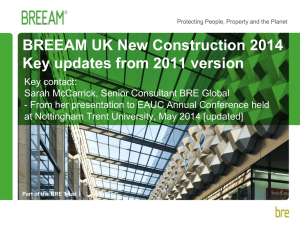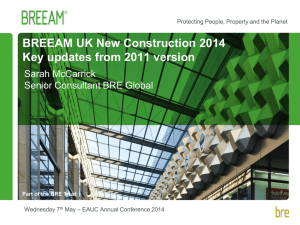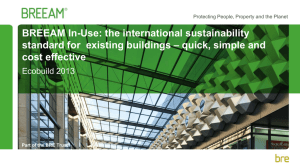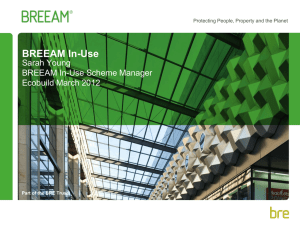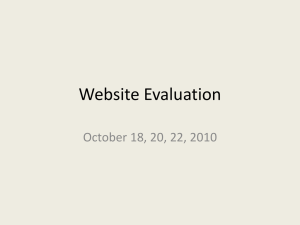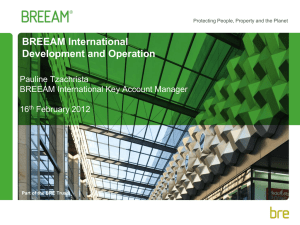Why BREEAM In-Use?
advertisement
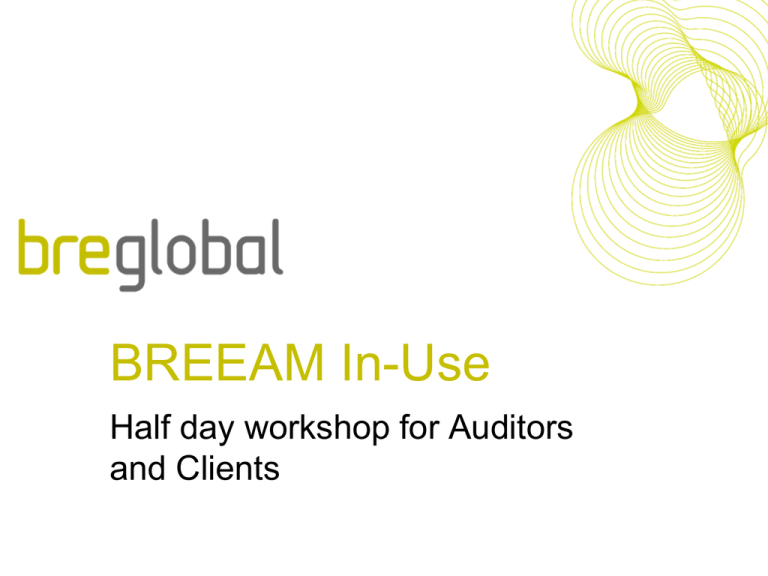
BREEAM In-Use Half day workshop for Auditors and Clients Overview of Course • • • • What is BREEAM In-Use? The BREEAM In-Use process How ratings are calculated Understanding roles – Client – Auditor – BRE Global • • • • How to use the system Performance management Certification process Next steps Why BREEAM In-Use? Existing New • Buildings contribute 40% of total UK carbon emissions • Total UK commercial office and warehousing floor space growth of 1-2% per year as percentage of existing (for a typical year) Projected age of UK non-domestic buildings 70% of these building pre-date 1985 Part L of Building Regs 40% of these building pre-date 1985 Part L of Building Regs BRE FB26 - Energy efficiency in new and existing buildings - Comparative costs and CO2 savings Shift in DEC distribution from 2009-2050 Ecological footprint Source: WWF Living Planet Report 2008 Ecological footprint USA 4.5 UK 2.6 Source: WWF Living Planet Report 2008 Japan 2.3 Germany 2.0 Global Average 1.3 Brazil 1.1 China 1 What is BREEAM In-Use? • The BREEAM In-Use assessment methodology launched in March 2009, is an Environmental and Sustainability Standard (BES 5058) designed to provide detailed and meaningful insight into the environmental performance of buildings throughout their entire operational life. • The Standard has been produced to enable the assessment of the environmental performance of: – the building (Asset Rating), – the operation of the building (Building Management Rating) and, – how Clients are managing their activities within the building (Organisational Rating). Who is it for? • Owners/occupiers/investors to: – monitor the sustainability specification of their buildings, – assess management and organisational practices, – produce action plan to manage and improve sustainability of the asset and occupying organisation. BREEAM In-Use aims to… Change behaviour Reduce running costs Improve staff productivity Demonstrate commitment to Corporate Social Responsibility (CSR) Provide a genuine badge of proven sustainability Protect and enhance asset value EDF Energy - Why interested in BREEAM In-Use? • Help EDF Energy to achieve corporate sustainability targets – reduce CO2 from offices & depots by 30% by 2012 – reduce CO2 from transport by 20% by 2012 – increase recycling of office & depot waste to 60% by 2012 – no office and depot waste to landfill by 2020 • To achieve this we need to understand status of sites, then identify & prioritise actions • Need something that is effective and easy to use EDF Energy – Approach to trial • • • • EDF property team gathered In-Use data BRE analysed & provided ratings of 19 buildings Presented in a range of graphical formats Prioritised range of measures to improve sustainability • Currently providing more detailed recommendations and planning to roll-out across EDF portfolio in UK • Interest from EDF colleagues overseas “From our business perspective, this is a massive differentiator” ...Trudi Cummins, Partner C&W Key terms… Glossary • Asset: – An asset defines the boundaries of which an preassessment can be carried out on a building, these boundaries being decided by the Client. For example: • The whole building, • A floor of a building, • Room of a building, • Wing of a building, • Separately managed tenanted areas. Note: An asset cannot include more than one building. Glossary • Auditor: – A BRE Global licensed practitioner qualified to assist Clients in the completion of their pre-assessment and/or to verify the pre-assessment within the terms of the Scheme, in order to provide certification. • BREEAM In-Use Online System – A web based software system used by: – Clients (and Auditors acting on behalf of Clients) to conduct BREEAM In-Use pre-assessments, and; – Auditors to verify the accuracy of their Client’s preassessment or measurement. Glossary • Client: – A person, business or organisation using the BREEAM In-Use process to pre-assess the assets they represent. • Portfolio: – A collection of assets owned or rented by an individual, group or company, represented by the Client. Glossary • Pre-assessment: – The process of producing dynamic scores against any, or all of the three sections of the BREEAM In-Use standard, generated by answering a series of questions falling under to the BREEAM In-Use Standard. – Pre-assessments are produced by either any qualified Client user or licensed Auditors, for use in internal sustainability reporting and ongoing performance management. – From start to finish the online pre-assessment process is designed to take no longer than 4 hours for each asset. Glossary • Verification: – The process of cross-referencing evidence to verify pre-assessments submitted from the Client-side, completed by licensed BREEAM In-Use Auditors. • Certification: – Issuing certificates against Parts 1, 2 or 3 of the BES 5058, Standard to Clients, completed by licensed BREEAM In-Use Auditors on behalf of BRE Global. BREEAM In-Use pre-assessment and certification pathway Scope of Standard • This standard is relevant to all non-domestic commercial, industrial, retail and institutional buildings. • Criteria is currently based on UK building regulations codes of practice, climatic conditions and energy methodology. Adaptation methods • Two methods to allow ‘confirmed’ ratings to be achieved outside of UK: 1. National Scheme Operator licensed to deliver countryspecific version under the International Code for a Sustainable Built Environment (ICSBE). – Dutch Green Building Council 2. BRE Global-delivered national version sponsored by external organisation. • Contact BRE Global for more information. Becoming an Auditor • To become licensed as a BREEAM In-Use Auditor, Clients must complete training and examination offered by BRE Global. – More information can be found at www.breeam.org/training. – A number of pre-requisites apply: • Delegates must also be a licensed assessor for one of the BRE Global Fire Risk, Energy or BREEAM assessor schemes. Independent Energy Scheme qualifications can also count towards becoming qualified. • Note: Auditors may not provide verification services to Clients by whom they are directly employed. The pre-assessment process BREEAM In-Use pre-assessment and certification pathway We are about to explore this stage. The pre-assessment process • This opens access to online and downloadable questionnaires that once completed, deliver pre-assessed ratings against any section of the BREEAM In-Use Standard. • Ratings are displayed on a dynamic dashboard providing a live update of the asset’s performance. • This enables Clients to continually evaluate and improve the performance of their asset, prior to seeking formal certification from licensed Auditors (optional). The pre-assessment process in detail Account registration Log portfolios Log assets Register Asset Measurement (£190) Watch webinar Take exam (£75) Renew Measurement (£190) Use KPI dashboard to pre-assess asset performance Renew registration annually or after verification, whichever is sooner. Verify results (Auditor charge paid offline) Use BREEAM In-Use dashboard to preassess asset performance How are ratings calculated? Glossary • Credit: – Awarded for meeting a specific environmental performance target within the BREEM In-Use questionnaire. • Category: All credits are grouped into one of 9 categories e.g. energy, water, waste, management, materials • Weighting: – A percentage factor used to control the contribution of credits towards the asset’s final BREEAM In-Use rating. Raw credit scores are multiplied by the category weighting factor assigned, resulting in an overall points score used to determine the asset’s final rating. Glossary • Point: – The weighted value of a credit expressed as a percentage point. • Rating: – An overall classification resulting from pre-assessment questionnaire answers. The rating expresses the performance of an asset against the BREEAM In-Use assessment criteria and ranges from Unclassified, Acceptable, Pass, Good, Very Good, Excellent and Outstanding, depending on the number of points scored. The same ratings can also be expressed from one star to six stars, Pass being one star and Outstanding, six. Rating calculation Questions within Categories • Answers to 197 questions contribute to the overall Asset, Building Management and Organisational ratings. • Questions are split between Categories and can be shared between Sections. • Answers provided lead to a certain number of credits being scored, depending on the performance represented. – Credits are weighted subject to the question category and converted to ‘points’. Points determine the overall rating achieved. • Answers are not required to every question although a greater number of answers will generally result in a greater number of points being attained. Categories of pre-assessment Existing weightings (%) Section / Category Management Part 1 Asset Part 2 – Building Part 3 Management Organisational n/a 15 12 26.5 31.5 19.5 Land Use and Ecology 9.5 12.5 5 Pollution 14 13 10.5 Materials 8.5 7.5 4.5 Waste 5 n/a 11.5 Water 8 5.5 3.5 17 15 15 11.5 n/a 18.5 Energy Health and Wellbeing Transport Categories of pre-assessment • Using the questionnaire, Client’s are able to gauge the asset’s performance in the following categories: – Management: • overall management policy, commissioning, site management and procedural issues. – Energy: • operational energy and carbon dioxide (CO2) issues plus DEC, EPC and EMS. – Health and Wellbeing: • indoor and external issues affecting health and wellbeing. – Materials: • environmental implications of building materials used, including life-cycle impacts. Categories of pre-assessment – Transport: • transport-related CO2 and location-related factors such as staff travel. – Waste: • Storage, policy, waste management – Water: • equipment, management policies and maintenance programmes intended to reduce potable water consumption. – Pollution: • air and water pollution issues. – Land Use: • ecological value conservation and enhancement of the site. Questions within Categories • Three main question types are used: – Tier 1 - questions where only one of a number of preset answer options must be selected. – Tier 2 - questions with one or more preset answer options. – Tier 3 - questions where user defined answers are entered using free text fields. For example, the amount of waste annually produced by an asset sent to landfill, • For questions where an answer is entered via free text, the response is also used to calculate one or some of the 12 KPIs. Questions within Categories • Although pre-defined answers apply to offices, retail and industrial buildings, ratings may still be achieved for different asset uses and organisations. • Various credits are awarded depending on the options selected / answers provided. • In addition to ‘tradable’ credits, there are certain mandatory requirements that must be attained in order to achieve a specific overall rating, – These are coupled to credit scores. • Please refer to the BREEAM In-Use Scoring Methodology document for more information – to be published. How are questions displayed in the online tool? Tier 1 • Questions where only one of a number of options must be selected for an answer: – A varying number of credits are allocated to preset answer options. – Some questions include answers as mandatory requirements for overall ratings! By selecting different answers a predefined number of credits are awarded and mandatory requirements are satisfied: Answer: Credits: (max 4) As a mandatory requirement for an overall rating of: a) environmental policies and/or procedures which are under development 1 Pass b) environmental policies and/or procedures are developed 2 Good c) environmental policies and/or procedures are endorsed by the board of directors/senior management 3 Very Good d) environmental policies and/or procedures have been developed with stakeholders consultation in compliance with the guidance given in the relevant BIU appendix (a helpful standard is BS 8900:2006, section 4.2) and stakeholders comments have been integrated. 4 Excellent e) Other or f) None 0 n/a Tier 2 • Tier 2 – Multiple preset answer options. – Each answer option carries 1 credit. The maximum possible number of credits scored is the total number of available answer options. – Some questions include answers as mandatory requirements for overall ratings! By selecting multiple answers credits are accumulated and mandatory requirements are satisfied: Answer: Credits (max 5): As a mandatory requirement for an overall rating of: a) scope and objectives defined 1 Pass b) targets are set and monitored to ensure that actions are completed 1 Good c) management arrangements include procedures to incorporate feedback from staff, Clients and other stakeholders 1 Good d) individual staff and/or champions are identified who 1 are accountable for implementation of the environmental policies, objectives and targets Very Good e) formal, regular training is provided for key environmental management staff Very Good 1 Tier 3 • Tier 3 – User defined answers. – Users are required to enter data specific to the asset or occupying organisation. – Such questions do not include answers as mandatory requirements for overall ratings. – Credits are instead scored for data availability. Approach to answering questions Approach to answering questions • What is the intent of the question? (refer to scoring methodology document to be published) • Has the intent been met? – Discretion needed to decide this. • Have you any evidence to back up your answer? • Would an Auditor be satisfied with my answer and evidence? Evidence • BREEAM In-Use Auditors are able to independently verify the answers provided to questions. • Clients must collate evidence to validate answers, transferring this offline to Auditors at the point of preassessment submission. • Auditors abide by a range of scheme requirements to ensure rigor and impartiality – see Scheme Document SD096 for more information. • A list of licensed Auditors can be found at www.greenbooklive.com. Evidence • As part of the verification Clients should expect an Auditor to ask for the following: – Copies (hard or electronic) of relevant documents • Front covers of documents • Relevant sections • Policies • Plans/drawings • Photos • If policies are referred to within the pre-assessment Auditors will want proof. Evidence for recertification • Certificates remain valid for a year after the date issued. • To recertify against Part 1 and 2, Clients conduct annual reviews alongside an assigned Auditor. • For Parts 1 and 2, the audit does not need to be as detailed as for initial certification, for instance by Client confirmation that no changes have occurred and Auditor spot checking compliance only. • Auditor still responsible for quality. • Part 3 requires full reassessment and recertification each year. • Parts 1 and 2 must be reassessed after two ‘lite’ audits. Evidence • Free text fields within the online system pre-assessment allow evidence to be referenced. • Shared InfoPortal links etc can also be used. KPIs • The online system is also being used by the International Sustainability Alliance to measure asset performance against 10 Key Performance Indicators. • For a limited period of time, BREEAM In-Use Clients can access the KPI dashboard at no extra charge. • For more information please visit www.internationalsustainabilityal liance.org. Flexibility to manage portfolios Glossary • Portfolio log: – The action of logging basic portfolio details to the online system, creating a record within which assets can be logged. • Asset log: – The action of logging basic asset details to the online system, creating a record against which measurements can be registered. Completed by online system users classified as either Portfolio Managers or the Portfolio Owner. Unless deleted by the users, logged portfolios and assets remain within the Client’s online system account indefinitely. Glossary • Asset measurement registration: – Registering new measurements against the asset log to provide access to the BREEAM In-Use online questionnaire and unlimited pre-assessment scoring against a dynamic BREEAM In-Use dashboard and for a limited period of time – a free KPI dashboards. – Measurements remains live for a period of up to twelve months, or until a certificate or KPI report is issued by a BREEAM In-Use Auditor, whichever is sooner. Glossary • Portfolio Owner: – Typically sustainability director or property directore for the Client organisation, Portfolio Owners have unlimited privileges within the BREEAM In-Use Online System, which, in addition to those held by Portfolio Managers (see below), will include: • creating a online system account for their organisation • purchasing credit and allocating Portfolio Managers and Asset Managers – Portfolio Owners are the Client’s main point of contact for BRE Global. Glossary • Portfolio Manager: – Person or persons responsible for control of the BREEAM In Use Online System pre-assessment as applied to designated portfolios of the Client's real estate. Portfolio Managers: • Log portfolios and assets for the Client organisation. • Perform BREEAM In-Use pre-assessments and KPI measurements. • Submit pre-assessments and measurements to Auditors for verification and certification. Glossary • Asset Manager: – Those identified by the Portfolio Manager as responsible for the pre-assessment of an asset. Portfolio Managers can also operate as Asset Managers. Typical business practice is for the Asset Manager to report to the Portfolio Manager. • Licensed Auditor: – A BRE Global licensed Auditor providing third party verification to the accuracy of a pre-assessment conducted by a Client user. Note: Auditors may act on behalf of the Clients by conducting pre-assessments. Scheme actors and system access BREEAM In-Use Actor Output Data Quality User classification: KPI Verification (verification gives the right to publicise rating) Verified BREEAM In-Use Certification (certification gives the right to publicise rating) Certified BREEAM In-Use Dashboard (live and dynamic update of pre-assessed rating) Pre-Assessed Data (certified pending Auditor verification) Auditor Training pathway: Prequalifications, BREEAM In-Use Auditor Training (see BREEAM website), Online Exam User classification: Client Training pathway: Online Exam Login page Login as Client team member responsible for pre-assessment of estate Home screen Status of portfolio pre-assessment Team member responsible for pre-assessment of portfolio Asset management screen Logged in as Client’s Portfolio Manager – can only view assigned Portfolios Client asset reference Unique online system asset reference Pre-assessment management screen Client’s Asset Manager (currently termed ‘Assessor’ by the system) responsible for pre-assessment of asset Pre-assessment dashboard Can log in as Client’s Asset Manager – can only view assigned measurements Online questionnaire Answers Free text field for Client and Auditor comments Offline questionnaire An interactive pdf document with all possible answers in drop down menus or tick boxes. Pre-assessment dashboard Live BREEAM In-Use score Pre-assessment dashboard Improve unverified score incrementally before verification Performance Management BREEAM In-Use pre-assessment and certification pathway We are about to explore this stage. System reports Summary of results and evaluation of scores The certification process BREEAM In-Use pre-assessment and certification pathway We are about to explore this stage. The certification process • At any point during the pre-assessment, Clients may apply for their answers to be verified by a BREEAM In-Use Auditor able to provide certification for the asset against Parts 1, 2 or 3 of the BES 5058 Standard on behalf of BRE Global. • The Auditor is assigned to the pre-assessment by the Client using the online system. • The Auditor validates pre-assessment answers against evidence submitted by the Client. The certification process • Certificates and Reports are awarded for separate assets and remain valid for a year after the point of award. • Certificates and Reports may be renewed subject to confirmation by the Client that no significant changes have been made to the asset or the occupying organisation’s policies. • Where either significant changes to the asset or its management have occurred, or two renewals have been completed previously, a full re-assessment is required against Parts 1 and 2 and a re-measurement against KPIs. The certification process • Certificates for Part 3 cannot be renewed without a full reassessment at least annually. • Clients pay offline certification fees to Auditors subject to the contract in place between both. BREEAM In-Use Certification • Asset rating – the building’s characteristics • Building Management rating – the operation of the building • Organisational rating – how occupiers are managing their activities within the building Verified KPI Report • Based on the relative consumption of the asset during the reporting period. BRE Global Quality Checks Auditor’s work BRE Global Quality Audits and Checks • Our checks ensure that that the integrity of the scheme is maintained. • BRE may ask questions about an audit or a representative of BRE may accompany the Auditor on site visits. Dealing with Complaints • In the unlikely event of a complaint, BRE Global will: – Investigate all complaints thoroughly and fairly in accordance with document PN100. • We will report back findings to all relevant parties. Fees • Measurement Registration Fee £190* • Certification Fee £250 per certificate* £50 per certificate £75* • Recertification Fee • Exam fee *exclusive of VAT • Auditor fees determined outside of online system. Contacts • BREEAM at BRE Global • Website: www.breeam.org • Email: BreeamTechnicalCS@bre.co.uk • Phone : 01923 664462 • Post : BRE Global, Garston, Watford, WD25 9XX
